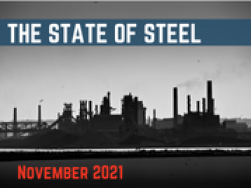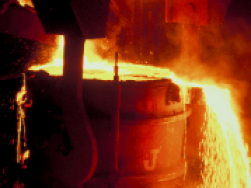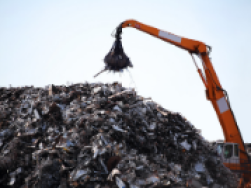State of Steel - November 2021
Pricing - Have we hit the top?
Steel price increases have seemed to peak and even slightly decrease over the last few weeks. Coil continues to be in high demand, but the tubing mills are beginning to get relief in the form of shorter lead times. For the first time in over a year, we saw weekly declines in the CRU for the entire month of October. Thus far in November, we have seen the first 2 weeks declining as well. Even though we have seen a recent decline, the CRU index has still seen an 80% increase in the steel index since the beginning of the year and a 155% increase since a year ago in November of 2020. For all structural tubing, Nucor Tubular and Atlas Tube (the two largest structural tubing mills) raised prices on September 28th by another $75/ton on HSS, pipe, mechanical, and piling products but quickly rescinded them. Since then, we have not seen any adjustments in structural tubing cost (up or down). It appears to have flattened out currently. With regards to DOM, we have not seen an increase since August 20th. Most DOM mill pricing has increased 13 times for a total of 89-92% overall since the beginning of November 2020. Cold drawn and hot rolled seamless tubing has seen 2 price increases in the last 3 months. The below charts reflect a current listing of all price increases on tubing that we have seen since late August of 2020.
The global IODEX benchmark price for iron ore hit $90/ton this week (before finishing the week at $94/ton), which was the lowest level since May 2020. Iron ore prices remain under pressure as Chinese steel production levels remain low and iron ore inventories continue to pile up, both at ports and at steel mills. (Source: SMU)
Steel plate prices in the US reached a new all-time high as the newest round of price increases were sticking. The cut-to-length plate price was assessed at $1,800/ton. (Source: AMM)


Pricing on Dura-Bar continuous cast iron bar has increased slightly in November due to the surcharges going up. Base prices increased in February of this year with additional significant base price increases (10% to 30%) implemented again on July 1st, 2021, and August 1st, 2021. ITS has just learned from the mill that beginning Dec. 1st, 2021, all Dura-Bar continuous cast iron base prices will be increasing another 8% to 10% across the board. The below chart details the Dura-Bar surcharges over the last year or so.

Lead Times
Understanding lead times for steel products are important to every participant in the supply chain. Lead times for steel products are as follows (as of 11/12/21):
Average HRC lead times declined significantly this week to 6.1 weeks versus an average of ~5.7 weeks since 2016. HRC lead times have now been flat or declined in 16 straight weeks and are down from their all-time high of 9.8 weeks reached in January 2021. Other product lead times also declined this week with CRC lead times at 7.8 weeks, HDG lead times at 7.9 weeks, and plate lead times at 8.0 weeks. (Source: Platts)
DOM Tubing lead times continue to be long and are anywhere from 25 to 32 weeks given the availability of raw steel coils, allocations, and orders already on the books. We continue to see material allocations, union strikes, and employment issues at various DOM tubing mills. Most lead times are out to July and August of 2022.
Structural Tubing mill lead times are running approximately 8-14 weeks upon receipt of order. Common sizes we can get sooner.
Dura-Bar Continuous Cast Iron mill lead times are approximately 10-14 weeks depending on size, grade, and finish. If it’s a large bar, special grade, size, or shape then the lead time could be even longer.
Metal Production
In the week ended November 6, US raw steel production decreased 1.0% week-over-week to 1.841mt (+14.3% YoY). US capacity utilization was 83.4% vs 70.1% last year, which is its lowest utilization since July 10. Year-to-date production is 80.720mt up 20.1% year-over-year from 67.189mt last year. (Source: AISI) Steelmakers around the world produced an estimated 156.8 million metric tons of crude steel in August, down 3.0% or 4.9 million metric tons from the month prior, reported the World Steel Association. The decline was largely driven by China. This marks the third consecutive monthly decline. (Source: SMU)
Algoma’s Board approved the previously announced construction of two EAFs expected to replace its current blast furnace operations over time. Production capacity is expected to increase to 3.7 million tons per year from 2.8 million tons currently. Algoma expects a 30-month construction phase with the EAF facility initially coming online in 2024. (Source: Bloomberg)
Scrap
The November scrap market settled with sources reporting that prices for shredded scrap rose $55-$75/ton depending on the region, and prices for prime scrap rose $20/ton month-over-month. According to sources, the dramatic increase in shredded prices was because inventories are low in dealers’ yards, winter is coming, and mill demand is very good. In addition, US shred prices had to catch up with the export increase that happened over the course of October. (Source: SMU)
Imports
According to the newly released state council guidelines, China will ban the creation of additional capacity for some energy-intensive industries, such as steel, coke, alumina and aluminum in a bid to control pollution. The guideline did not specify the areas to be subject to the ban or the date that the measures will take effect. (Source: AMM)






